Japan Sea
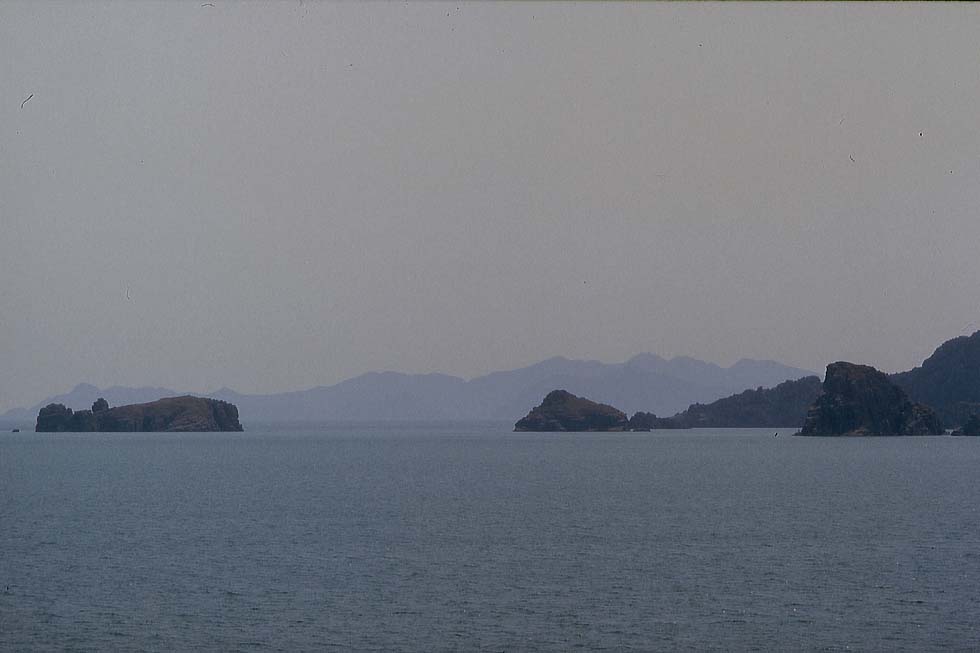
Off the Korean coast (WS)
Japan under the Tenno made contact with the Chinese culture during the Korea campaign around 550 A.D. Under emperor Matsuhito modern Japan emerged in the 19th century. It maintained its identity - but a rival appeared at the coast of the Japan Sea.
Russia - Far East
After the collapse of the Mongolian rule in the 15th century and liberation under Tsar Iwan I, Russia started to discover the east. Tsar Alexander II gave order to erect in 1860 the naval base Vladivostok as port of access to the Japan Sea. In the 1870s studies for a Siberian Railway were undertaken. In 1877 Alexander II founded the Volunteer Fleet or Dobrolyot, starting to connect European Russia with Vladivostok by the sea-route from 1880 on - see main chapter Indian Ocean/ Other Flags. The official Guide of 1900 stated: "From Vladivostok, the sea-route by the waters of the Pacific Ocean lies open to the steamers of the Volunteer Fleet and to those belonging to the East Chinese Railway and likewise to steamers of foreign countries". A map showed services from Vladivostok and Nikolayevsk to Korsakov on Sakhalin island, Korsakov - Japan, Vladivostok - Dalian and China as well as from Vladivostok to the west coast of Japan. For Vladivostok, agencies of the Volunteer Fleet, the Amur Steamship Co., Nippon Yusen Kaisha and the Japanese Steamship Co. 'O'une' were listed.
The 'Peter the Great Gulf', as it was called, necessitated ice-breakers during winter months. About Sakhalin the Guide of 1900 informed: "Regular navigation commences in the middle of May, when the mail service is performed by the steamers of Sheveliov and Company, subsidized by the Government (...). The mail steamers run into Port Korsakov not more than once a month (...). During the remaining winter months, the post is carried by dogs from Nikolayevsk (...). Passenger traffic is also performed with sledges...".
Later information ascribed to the Volunteer Fleet services to Sakhalin, to the Bering Sea and once yearly to the icy mouth of the Lena river in the Arctic. Existence of the extended routes was (according to TheShipsList) confirmed by the loss of the "Kostroma" (1888/ 3,513 gt), which was wrecked in 1913 on a voyage from Vladivostok to the Kamchatka peninsula.
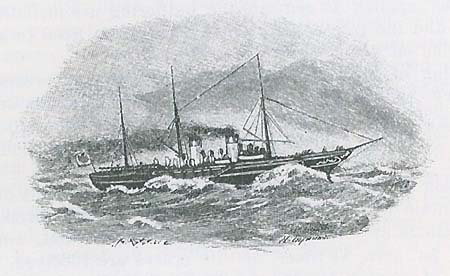 A Russian steamer, drawing published in 1900
A Russian steamer, drawing published in 1900
Connecting with the Trans-Siberian
The fastest connection from Europe to the Far East was by the Trans-Siberian railway, which enabled from 1903 on a travel to Japan via the ice-free harbour of Dalian on the Yellow Sea - see chapter Branch Lines/ Yellow Sea. After Japan defeated in 1905 the Russian fleet in the battle of Tsushima in the Korea Strait, Russia had to retreat from The Yellow Sea and Tsar Nicholas II put back his aggressive ambitions. Since that victory the Japanese Empire dominated also the Japan Sea.
Already in the 19th century Vladivostok was connected by Japanese mail steamers. Cook's timetable listed e.g. in 1897 the line Kobe - Shimonoseki - Busan - Vladivostok. After the Russo-Japanese War a state-owned train and the 'Transsiberien-Express' of Wagons-Lits connected from 1906 or 07 on Russian broad gauge for the first time Irkutsk with Vladivostok via Harbin in the Russian-occupied part of Manchuria. And since 1906 the Russian Far East port was served by the Osaka Shosen Kaisha steamers from Vladivostok to Tsuruga on the Japanese west coast. In May 1914 the 'Transsiberien' was extended to run Moscow - Harbin - Vladivostok and a map indicated Russian Volunteer Fleet steamer routes Vladivostok - Tsuruga and Vladivostok - Nagasaki - Shanghai, showing the two-funnel steamer "Simbirsk". At Tsuruga passengers could change to the express Tsuruga - Tokyo, started in 1912. An advertisement in Bradshaw's Continental Guide praised the connection as "The Trans-Siberian Route London - East Asia in 13 days".
During World War I, the Tsar's troops fought on the side of the Allies and Japan. 'Courier' expresses continued to cross Siberia. Not before 1916 the Amur railway was completed, the longer way to Vladivostok, circumventing Manchuria. When the Tsar evaluated a peace treaty, it was U.S. President Wilson who prevented an Allies' attack on the Russian Far East. In 1917 the Tsar was overthrown and under the Bolshevists a bloody civil war tortured the country. The 'Ataman' Semyonoff became a sole warlord of the Transbaikal region, his residence being a robbed de-luxe train, stationed at Vladivostok, always ready for departure ("One never knows...", he told a journalist). In February 1918 the Japanese landed at Vladivostok, in September followed by a U.S. expedition corps, but around 1920 the Bolshevists founded there an intermediate "republic". In 1922 their Red Army took over Vladivostok.
Since 1920 Vladivostok could be reached from Harbin once again on the shortest route via the Chinese Eastern Railway and from November 1922 on the connecting Wagons-Lits train of that Chinese region was the 'Transmanchourien Express' from Harbin, then from Manzhouli, to Vladivostok. In 1925 however, the Soviets introduced their own 'Courier' from Moscow to Vladivostok, omitting Chinese territory by taking the longer Amur route via Khabarovsk.
In the same year 1925 the Soviet Union re-organized shipping under the label Sovtorgflot. About the Japanese port Nagasaki, which had been a refuge for Volunteer Fleet ships during icy winter months, TheShipsList reported: "In 1926, after the fleet stopped calling here, the Nagasaki City Chamber of Commerce made an unsuccessful effort to have the Russian steamers return to the port."
To Japan via Korea
Korea, submitted to the Chinese dynasty, was conquered by Japan in 1894/95 and suffered a formal annexation in 1910, named Chosen. The shortest way from Japan is by crossing the Korea Strait, reaching the Korean harbour of Busan (Fusan, Pusan). That port got a rail connection with Seoul (by the Japanese called Keijo) in 1904/1905. It was linked with the Trans-Siberian route by an extension of the South Manchurian train from Changchun to Busan pier in 1912, praised as the 'Manchuria-Chosen Express', connecting with an express ferry Busan - Shimonoseki and an express train Shimonoseki - Tokyo.
The de-luxe train from Changchun continued running even during WWI until the end of 1916 and a passenger, the only one on that day, wrote down his impression in Railway Magazine: "We reached the Fusan pier sharp at 7 am after they had served me with an early breakfast in the dining car, and I was bowed off the train in great style by the entire staff. It would have been very effective if I could add that I was the only passenger on the "Shiragi Maru" from Fusan to Shimonoseki, but this was not to be. The ordinary train had arrived about 30 min earlier and had unloaded its passengers into the steamer. All those good people had to wait until my train arrived, and it was an impressive, if somewhat embarrassing, business walking alone across the wide pier and having to listen to the buzz of excited chatter as to who the distinguished passenger might be, and then having the gangway withdrawn the moment I had stepped aboard".
 "Shiragi Maru" of Kampu N.R. at Shimonoseki (old card, coll. WS)
"Shiragi Maru" of Kampu N.R. at Shimonoseki (old card, coll. WS)
About this shipping route, William A. Pearce (see note below) reported that in September of 1905 the Sanyo Railway Co. set up a passenger service between Shimonoseki and Busan. For this run the Sanyo Co. obtained two fast passenger ships "Iki Maru" and "Tsushima Maru" ... "In 1906 the Sanyo Steamship Co. was nationalized and became known as Kampu N.R. The chartered 1,680-ton steamers had a black hull, white superstructure and a buff funnel with the red letter "I". In 1913 two new 3,000-ton steamers, the "Koma Maru" (scrapped in 1933) and the "Shiragi Maru" entered service, followed in 1922-23 by the turbine-powered "Keifuku Maru" "Shokei Maru" and "Tokuju Maru"of 3,600 tons each and in 1937 by the 7,000-ton "Koan Maru" and "Kongo Maru". The proudest ships were the "Konran Maru" and "Tenzan Maru" of almost 8,000 tons, built for a speed over 23 knots, introduced in 1943. Due to WWII, the hull, superstructure and the two funnels were painted grey.
Other International Branch Lines
The famous Japanese company Nippon Yusen Kaisha had been created in 1865 by amalgamation of Kiodo Ungu Kaisha and Yubin Kisen Mitsubishi Kaisha. The company operated, apart from trans-oceanic services, an extensive network of branch lines. At the outbreak of World War I, it comprised the routes from Yokohama to Northern China and to Shanghai, as well as a still greater number of services from Kobe to Vladivostok, to Otaru in Northern China and to Keelung, Formosa. From the 1930s employment of the 5,250-ton "Nagasaki Maru" and "Shanghai Maru" as the fastest Japanese ships on the Japan - China route is reported. The Bonin Islands Line linked remote islands of the Pacific Ocean. Japan's port Yokohama was connected from 1872 with Tokyo by a Cape gauge railway, in 1889 extended to become the Tokaido line.
The island of Taiwan had been annexed by Japan in 1895, then named Formosa. It became served by trans-Pacific liners and also by the Formosa Line of Nippon Yusen Kaisha from Kobe and Nagasaki to Keelung. There were other Japanese steamers, too, and one of them was the "Horai Maru" (9,192 gt) of the Osaka Shosen Kaisha, described by Laurence Dunn: Built in 1912 as the "Indarra" of the Australian SN Co., later used by the Lloyd Royal Belge, she was rebuilt in Japan in 1924 and became employed on the Kobe - Keelung route together with two other ships, one of them the "Midzuho Maru" (8,112 gt), the former "Infanta Isabel" of the Spanish Pinillos Line. Keelung, the important harbour for the Japanese, was connected from 1908 by a Cape gauge railway with the southern harbour Kaohsiung.
There were obviously no great changes until Japan's full-scale war on China in the 1930s and World War II.
Pacific War Routes
The Japanese Empire fought the China War already for several years, when it started the war on the Americans, British and Dutch in late 1941. From 1942 the Kammon Undersea Rail Tunnel connected Japan's main island Honshu with the southernmost island Kyushu and by that way a new connection with Korea was opened in 1943 with the Hakpu N.R. shipping route from Hakata on Kyushu to Busan. The "Shokei Maru", "Tokuju Maru" and then the "Keifuku Maru" were repositioned to that route. In September 1943 the American submarine "Wahoo" became famous for entering the Japan Sea, sinking several ships, including the "Konran Maru". Under the government organization Senpaku Unei-Kai regular shipping on the Pacific Rim, known as the 'colonial routes', was kept on until 1944. Until that year also the special trains Tokyo - Yokohama port and Kyoto - Kobe, connecting with steamers, were listed. In early 1945 however, five ships of the Kampu N.R. were either sunk or severely damaged. "On the 20 June 1945 the Ministry of Transport decided to suspend regular shipping operations to Korea, and from thence forward the ships from the Kampu and Hakpu N.R.S operated an irregular service from small harbours on the Japan Sea coast" (W.A. Pearce). Japan was virtually defeated by being cut-off from its resources. After the nuclear attacks on the people of Hiroshima and Nagasaki, Japan capitulated on 14 August 1945.
Karafuto Routes
Japan had not been at war with the Soviet Union, enabling Stalin to send his troops westward to fight the German aggressors. Not before August 1945 the Soviets declared war on Japan. From 1920 Japan had been in possession of Sakhalin Island off the Russian coast, named Karafuto, its harbour and railway terminal Otomari (Korsakov) being connected with Wakkanai on Hokkaido by the Chihaku N.R. Initially the old "Tsuhima Maru" and "Iki Maru" had been employed and then they were replaced by the ice-breaking "Aniwa Maru" and "Soya Maru". During the last days of WWII they evacuated the Japanese from Karafuto. Then the whole island became Soviet-owned Sakhalin. Also the lonely Kurile Islands came into Soviet ownership. After the end of the war, Japanese ships were used for repatriation of troops from overseas under American control.
Japan Domestic in the Past
The coastal steamers and railway-owned steam ferries of the past as well as nowadays' car ferries connecting the main island of Honshu with Shikoku and Kyushu in the north are a matter going far beyond that treatise. Very helpful is the survey by William A. Pearce of the Japan Domestic Ship Society and a report by Tsuyoshi Ishiyama, published by the German magazine Ferries (3/2005).
Of course the islands of Japan were always reached by boats. About the start of railway-connected ferries, W.A. Pearce reported: "The first of Japan's railway ships did sail on the fresh water of Lake Biwa, the large lake to the north of Kyoto. In the early 1880s the Government Railway's Tokaido line was being built from Tokyo to Osaka, by way of Kyoto, and by 1882 its head of construction was approaching the eastern side of Lake Biwa from the north. To connect onwards to Kyoto, in 1882 the Taiko Steamship Co. was formed, whose purpose was to run a ferry service from the small lake port of Nagahama down to Otsu, from whence connection could be made to Kyoto. For this service, two single-screw 516 ton steamers (...) began operating the Otsu-Nagahama N.R. in 1884. These two ships were built by one Kirby, who is quoted as being 'an English resident of Kobe'...". Also the first railways were built under leadership of an Englishman, chief engineer Morell. The rails reached the harbour cities of Yokohama in 1872, Kobe in 1874 and Tsuruga in 1884, initially including a Lake Biwa shipping route. In 1889 the Tokaido main line was completed and the Nagahama - Otsu shipping route became obsolete. From 1901 the Sanyo Railway Co. linked the Tokaido line with Shimonoseki on the Kammon Strait, the port of departure for Korea. Sanyo steamers connected from 1903 Shikoku island and already from 1897 Kyushu Island in the south, first with Tokuyama and from 1901 with Shimonoseki as port of departure.
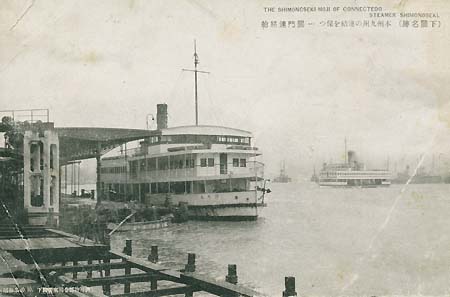 Shimonoseki pier (card of 1910, coll. WS)
Shimonoseki pier (card of 1910, coll. WS)
The Tsugaru Strait in northern Japan was crossed by steamers of the Japan Mail Ship Co., which operated between Aomori and Hakodate on Hokkaido island. In 1891 the Nippon Railway reached Aomori and from 1914 goods wagons were transferred across the Strait by the Seikan N.R. (see also the chapter about train ferries). From 1924 the Shohu Maru class was introduced, 2,400-ton cargo-train ferries, taking also passengers. In 1954 a tragedy occured when a typhoon sank five Seikan ferries and 1,000 people went down with the "Toya Maru". In the 60s the old ships were replaced by diesel-powered 8,300-tonners of a completely new appearance, painted light-blue with a white superstructure. Opening the Seikan Undersea Tunnel in 1988 meant the end of the Seikan Renrakusen services. In 1998 also the Uko N.R. route to Shikoku was closed down due to completion of the Grand Seto Bridges.
Japan Domestic Car Ferries
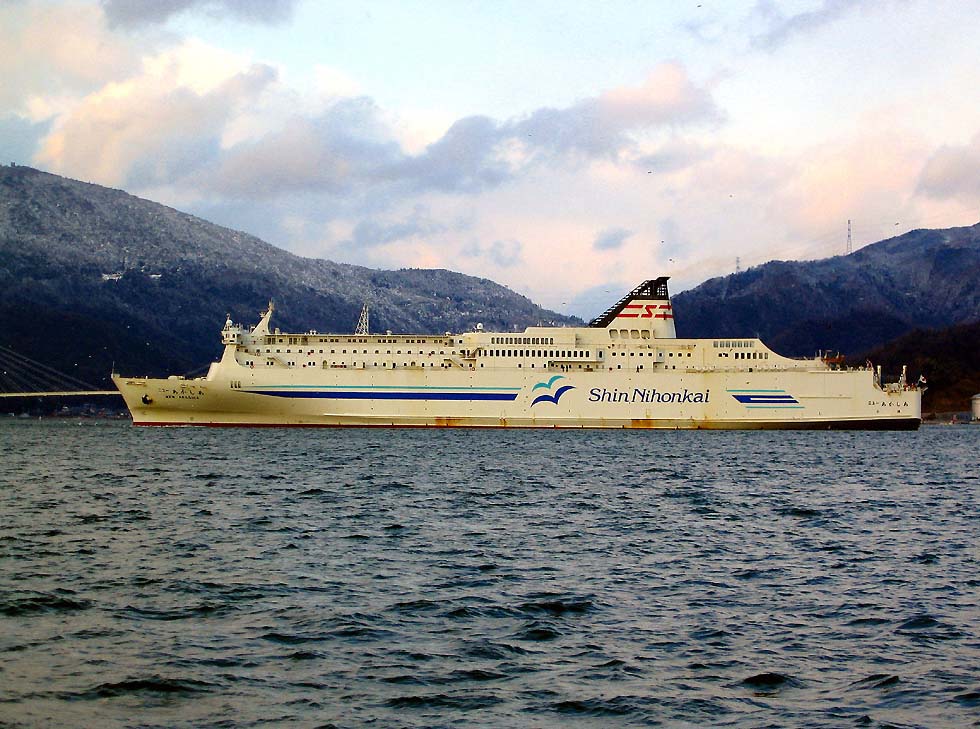
"New Akashia" of Shin Nihonkai Ferry, 2004 (NKNS, via Wikimedia)
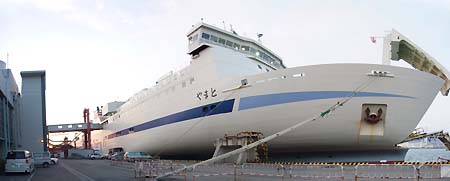 "Yamato" of 2003, Hankyu Ferry, Kobe 2009 (hashi photo, via Wikimedia)
"Yamato" of 2003, Hankyu Ferry, Kobe 2009 (hashi photo, via Wikimedia)
The modern age of car ferries had begun in 1954 with services on the Inland Sea between Akashi on Honshu, Awaji Island and Shikoku. The further development was described by T. Ishiyama: As during the first economic boom in the '60s the road network proved completely insufficient, Hoshu Iritani, President of Kanko Kisen, had the uncommon idea of providing ferry services parallel to the coast. His company Hankyu Ferries opened in 1968 a route from Koge southward to Kukura on Kyushu island with the "Ferry Hankyu". Then Hoshu Iritani founded Shin Nihonkai Ferry, inaugurating in 1970 a west coast service between Tsuruga/ Maizuru and Otaru, later Tomakomai, on Hokkaido Island with the "Suzuran Maru" (9,991 gt, later the "Poseidon" of Med Link), followed by the "Ferry Hamanasu" (1972/ 9,875 gt, later the "Lissos" of ANEK) and "Ferry Akashia" (1973/ 11,210 gt, later the "Filipina Princess"). Shin Nihonkai owned also the "Orient Venus" (1991/ 21,884 gt), cruising for Japan Cruise Lines. Ships with 'cruise ferry' comfort were introduced by Shin Nihonkai Ferry. Their "New Akashia" (1988/19,796 gt) and "Ferry Lavender" (1991/ 19,904 gt) found their way to Greece as "Ionian Queen" of Endeavor Lines and "Ionian King" of Agoudimos Lines. Among the new vessels, which replaced them on the west coast routes to Otaru, the "Hamanasu" and sister "Akashia" (2004/ 16,810 gt) were exceptions with their pod propulsion and a speed up to 32 knots. Then the big SHK Group was listed (via Internet, 2011) with ferry operations by Hankyu Ferry, Kampu Ferry, Orient Ferry, Shin Nihonkai Ferry and Shanghai-Shimonoseki Ferry.
Another market was built up with 'luxury' ferries, represented by the "Sun Flower" ships of Kijiro Nakagawa and his company Nihon Kosoku Ferry, described in detail by T. Ishiyama: The first "Sun Flower" (11,312 gt) with the red/orange flower paint on the white hull entered service in 1972 between Nagoya on Honshu and Kagoshima in the south of Kyushu, followed by the "Sun Flower 2", 5, 8 and the twin-funnel 11, operating from Tokyo or Osaka. The economic crisis of Japan led to a takeover of the services by Blue Highway Line, then divided up to several companies. The old ships were sold, mainly to the Philippines, but also new ones got "Sun Flower" names, listed for Shosen Mitsui Ferry/ Higashi Nihon Ferry and Kansai Kisen. In 2009 Lloyd's List reported the merger between Kansai Kisen Kaisha and Diamond Ferry and informed: "Mitsui OSK Lines... will merge two of its ferry companies into a new holding company, Ferry Sunflower. The mighty MOL Group was listed (via Internet, 2011) with ferry operations by Ferry Sunflower, MOL Ferry and Meimon Taiyo Ferries.
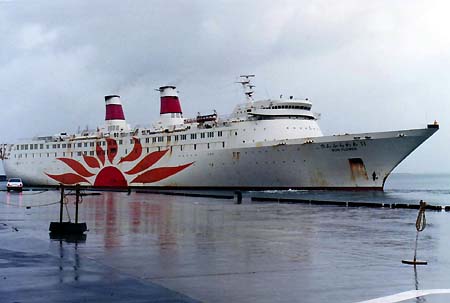
"Sun Flower 11" of Nihon Kosoku Ferry, 1984 (pinqui, via Wikimedia)
|
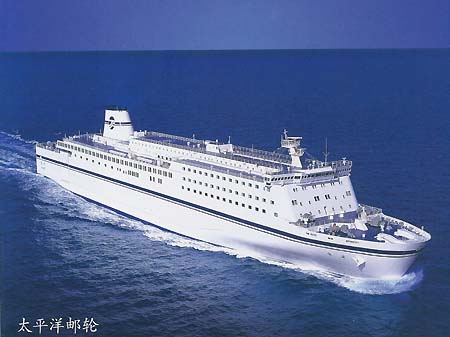
"Kiso" of 2005, Taiheyo Ferry (advertisement)
|
Taiheiyo Ferry, connecting Nagoya with Tomakomai on Hokkaido Island by a route along the east coast replaced older ships and the "Kiso" of 1987 became the "Ocean Trailer" and then "Nissos Rodos" of Hellenic Seaways. The new "Kiso" (2005/ 15,795 gt) was described as Japan's most luxurious ferry, like the older "Kitakami" and "Ishikari" even with de-Luxe suites and a theater. As a substantial yield is coming mainly from truck transport, some companies however confined their operations to pure ro-ro services. And the history of Japan's domestic shipping continued with many companies, brand names and innumerable itineraries, impossible to describe by this worldwide survey.
Japan Hi-Speed
Nowadays, Shinkansen high-speed railways are connecting Honshu with Hokkaido and Kyushu, gigantic road bridges have been built and air transport developed. Nevertheless, ShipPax listed more than fifty companies providing domestic car ferry services and a dozen among them also operating high-speed services. A high-speed air-cushion craft, the "Kamome", was tried in 1971 on the Uko N.R. route, but this concept was taken no further. The "Ocean Arrow" is a car-carrying 1,678-ton SSTH of 1998, developed by Professor Hideaki Miyata, listed for Kumamoto Ferries on Kyushu. The first InCat catamaran surpassing the 10,000-ton barrier was the 112m-type "Natchan Rera", introduced in 2007 by Higashi Nihon Ferry, followed by the "Natchan World", competing between Honshu and Hokkaido with various other boats. Between Atami and the island port Oshima, Cook's timetable listed e.g. in 2008 a 'Semi submerged Catamaran' of Tokai Kisen. The "Super Liner Ogasawara" of 13,923gt, built in 2005 at Mitsui Zosen for a speed of 42.8 knots, was not introduced by Ogasawara Kaiun due to high fuel consumption on account of gas-turbine engines (according to 'Die grossen Passagier-Schiffe der Welt').
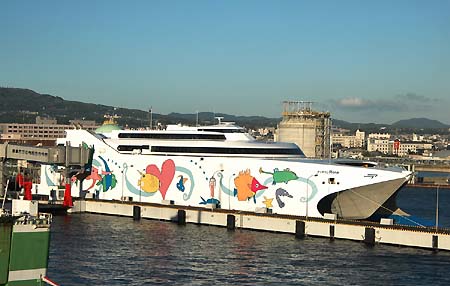
"Natchan Rera", Higashi Nihon Ferry (Moga, via Wikimedia)
|
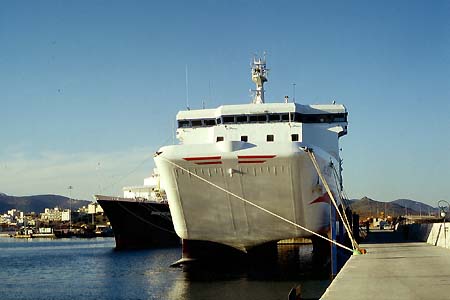
The former "Yamatohama" as "Alkioni" in 2006 at Lavrion, Greece (WS)
|
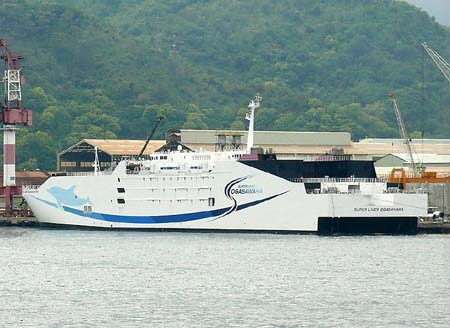 "Super Liner Ogasawara", 2008 ( Mamo, via Wikimedia)
"Super Liner Ogasawara", 2008 ( Mamo, via Wikimedia)
Korea Ferries
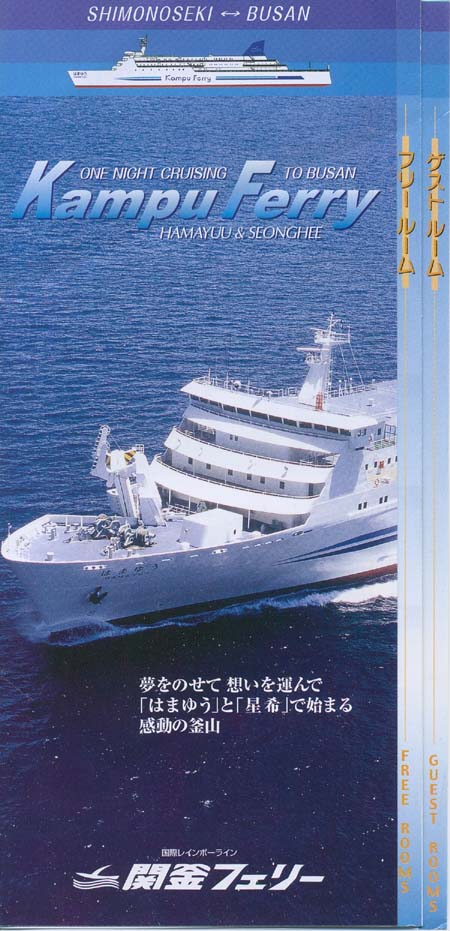
"Hamayuu", Kampu Ferry (ad of 2008)
|
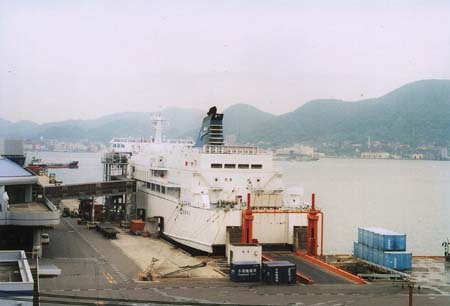
"Seonghee" at Shimonoseki, bound for Busan, 2008 (Heiko Mueller)
|
The main harbour in Korea for ferries from Japan was always Busan, nowadays connected with the capital Seoul by high-speed trains. In the age of car ferries, the Japanese pioneer Hoshu Iritani founded Kampu Ferry. In 1970 he opened services on the traditional Korea Strait route Busan - Shimonoseki with the "Ferry Kampu", joined by Pukwan Ferry of Korea. Kampu maintained the service, its "Hamayuu" of 1998 being a typical 16,000-ton vessel, but Pukwan Ferry sold its "Seonghee" to cooperating Kampu (maintaining the Soanghee label) and "Eun Ha" to SAOS of Greece (renamed "Panagia Agiassou"). Kampu Ferry praised the voyage to Korea aboard the "Hamayun" and "Seonghee" as the 'Korean Romantic Cruise'. Kampu Ferry, Shanghai Shimonoseki Ferry and Orient Ferry (see chapter China Sea) are listed (by Wikipedia, 2011) as parts of the SHK Line Group.
The other route Hakata - Busan of 115nm length was covered in 2 hours 55 minutes by JR West with their "Beetle" hi-speeds, by Korea Ferry and Korea Marine Express, while the car ferry of Camellia Line under Japanese flag took 13 ½ hours. Then the hi-speeds of Korea Ferry and Korea Marine Express dominated the Hakata run. On a long route from Busan to Osaka, PanStar of Korea has introduced the "PanStar Sunny", described as the former "Sun Flower Mito", in 2009 acquired by COSCO of China as "Cosco Star". A list (via Internet, 2011) mentioned for Japan services from Busan the Korean Ferry with the "New Camellia", Mire Jet with the hi-speeds "Beetle 2" and "Kobee", Pukwan Ferry and PanStar Cruise Ferry. Other South Korean companies are maintaining various coastal and island routes, also with hi-speeds.
Astonishing was the introduction of a service from South Korea to North Korea between Sokcho and Chongjin, the harbour near the Russian border, by Hyundai Asan. Their car ferry "Hyundai Seolbong" on this service was replaced in 2004 by a smaller, faster vessel. Hyundai Asan of the famous Hyundai Group has pioneered tour operations to the Kumgang mountains in North Korea. It is considered a major investor in this country and "has faced accusations", as a Wikipedia information expressed it, when trying to enter this most isolated country by its own way. After an incident in North Korea, the service was interrupted.
Until 2005 even a once-monthly passenger-cargo service connected Wonsan in North Korea with the Japanese port of Niigata, employing the "Mangyongbong 92". A North Korea-friendly connection within Japan was considered the cause. After the first North Korean nuclear bomb test the service was stopped.
Dong Chun Ferry was listed e.g. by ShipPax 2006 with the "Dong Chun" on a route from Sokcho in South Korea to the Russian harbour Zarubino and further on to Hunchun. Later the "New Dong Chun" appeared on the route Sokcho - Zarubino - Vladivostok. Another company, DBS Cruise Ferry, started a service between Japan, South Korea and Russia with a route Sakaiminato - Donghae - Vladivostok.
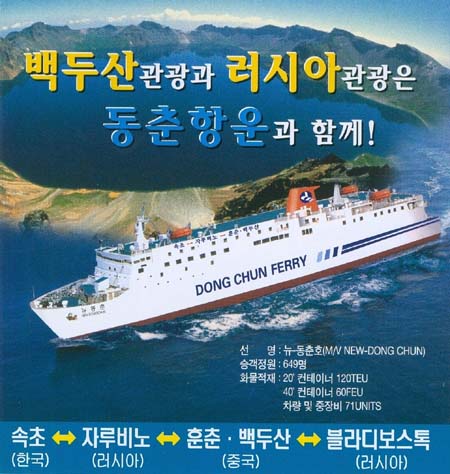
"New Dong Chun", Dong Chun Ferry (advertisement)
|
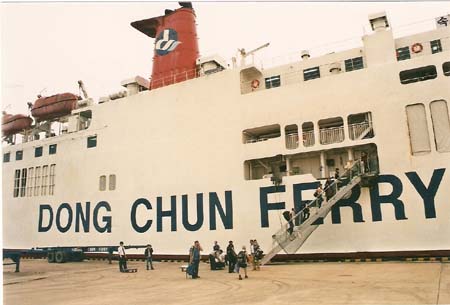
"New Dong Chun", 2009 (Heiko Mueller)
|
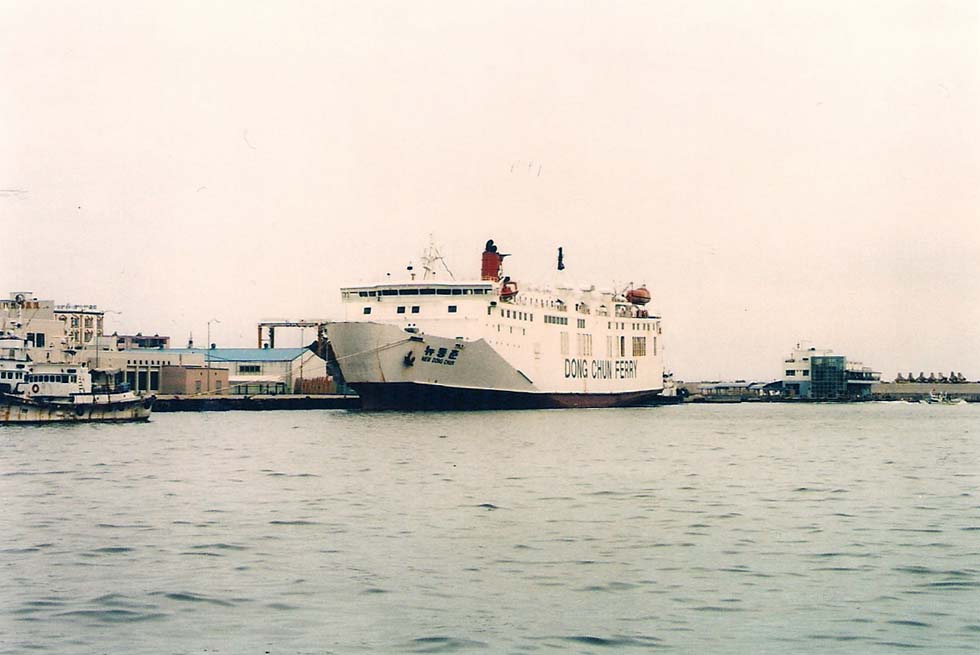
"New Dong Chun" at Sokcho, bound for Zarubino, 2009 (Heiko Mueller)
Soviet Union Branch Lines
On the Soviet side, the Far East harbour Vladivostok was during all the past decades a place of strategic importance. After the Bolshevists had interrupted traffic, it got a direct 'Kurier' train connection with European Russia in 1925. With World War II, Vladivostok once again became tightly closed. The fate of some ships, transferred after WWII to Sovtorgflot and employed in the Far East, became known: The 23,009-ton "Sovetskiy Soyus" was the turbine-steamer "Albert Ballin", then "Hansa" of Hapag, in 1955 completely rebuilt with a single streamlined funnel. The 12,931-ton motor-ship "Ilyich" was the former "Caribia", completed in 1933 for Hapag, in 1946 handed over to the Soviets. Sister "Cordillera", sunk by bombs in 1945, was repaired and entered service in the early 50s as "Russ". Refurbishing the former "Sierra Morena" (1924/ 11,430 gt) of NDL, then "Der Deutsche", damaged during WWII, was completed in 1950 as "Asiya". These ships were employed between Vladivostok and the submarine naval base Petropavlovsk, a route of special importance, for this remote Kamchatka region is not connected by rail. Also the former German train ferries "Deutschland" and "Preussen", renamed "Aniva" (another source mentioned "Orion") and "Krilyon", were rebuilt for Vladivostok - Kamchatka services. The 3,870-ton motor-ship "Smolniy", built in 1929 for the Leningrad - London route, changed to Vladivostok. The German steamer "Oceana", built in 1913 for NDL as "Sierra Salvada", used in 1945 as a British navy hulk, in 1946 handed over to the Soviets, was employed as "Sibir" for services from Vladivostok and went to the scrapyard in 1958.
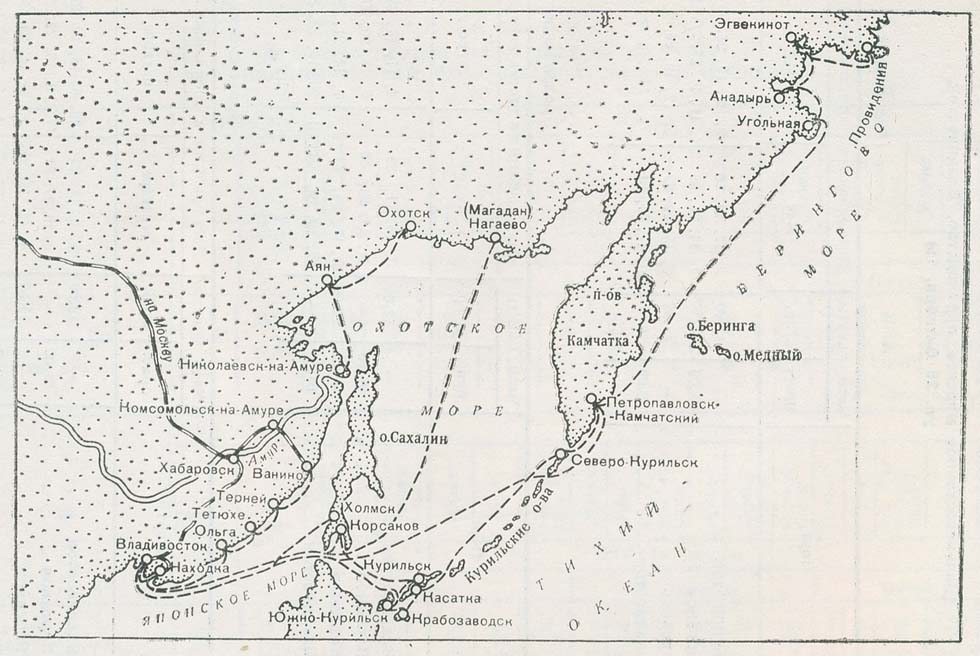
Official map of 1971 (coll. WS)
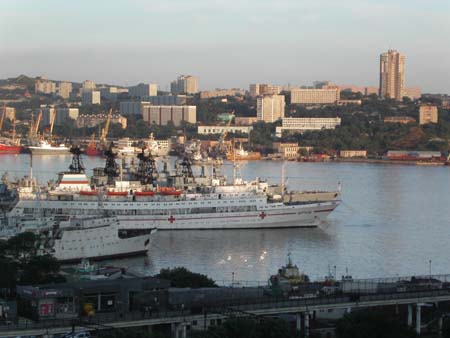 "Irtysh" as a Red Cross ship, Vladivostok Bay, c.2003 (Qaramazov, via Wikimedia)
"Irtysh" as a Red Cross ship, Vladivostok Bay, c.2003 (Qaramazov, via Wikimedia)
The Spravochnik Passazhira of 1971 listed the direct line Vladivostok - Petropavlovsk, Kamchatka, with the motor-ships "Sovetskiy Soyus", "Ilyich" and "Russ", express lines Vladivostok - Korsakov with the "Krilyon" (described as a motor-ship), to Kholmsk on Sakhalin island with the steamer "Beloostrov", to Nagayevo (Magadan) with the "Smolniy" and an isolated route between Nikolayevsk in the mouth of the river Amur and Okhotsk with the "Nevelsk". The "Asiya" abandoned service in 1967, the "Russ" in 1977 and the "Sovitskiy Soyus" was scrapped in the early 80s. They were replaced by newer ships.
The green volcanic Kurile Islands, Soviet outposts close to Japan, were connected during the Cold War by the new "Turkmeniya", "M. Uritzkiy" and "Priamurye", 5,261-ton motor-ships of the series built from 1963 in East Germany. The longest route, served by the motor-ship "Turkmeniya", was Vladivostok - Providenye on the Bering Sea. A voyage to the river Lena did not appear in the timetable and now the harbour Tiksi, close to the river mouth, is devastated. The Soviets' megalomaniac plan to build a canal from the Pacific to the Lena was never realized. A road, the Kolyma track, was built from the Pacific to world's coldest region by hundreds of thousands of Stalin's prisoners. They had been carried by ship to the port of Magadan and almost all of them died in the icy region.
Siberia - Japan
The Soviet Union opened the Trans-Siberian route to foreigners in the 60s. As Vladivostok being a naval base, the shipping service to Japan was provided by a new route from Nakhodka, a railway terminal north of Vladivostok, to Yokohama. The service started in 1961. ?he "Ordzhonikidze", used on this route, was replaced by the "Khabarovsk" and the "Baikal" (5,261 gt) of 1964 and then also the "Felix Dzerjinski", operated by the Far East Shipping Co., abbreviated FESCO. During the '80s the service Nakhodka - Yokohama was extended to Shanghai. Generally these motor-ships were built in East Germany. The "Konstantin Chernenko" (9,885 gt), built in Poland and then renamed "Russ", followed in 1987. In 1994, after the end of the Soviet Union, the route changed to Vladivostok - Niigata and Fushiki and the Shanghai service disappeared. The "Russ" was chartered for Baltic Sea services in 1996 and then she returned to the route from Vladivostok to Fushiki, were a train connects only with nearby Takoaka.
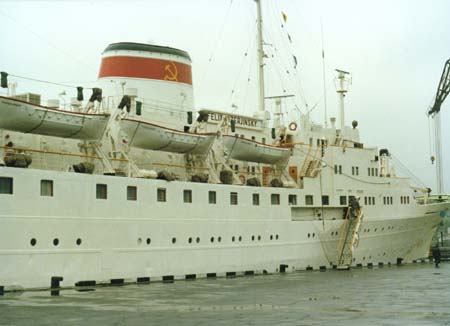 "Felix Dzerjinsky" at Nakhodka, bound for Yokohama, 1977 (Karl-Heinz Walraf)
"Felix Dzerjinsky" at Nakhodka, bound for Yokohama, 1977 (Karl-Heinz Walraf)
Sakhalin Connections
Sakhalin, the remote island belonging to Russia, is connected with the Russian mainland by ferries. They depart from Vanino, where passengers arrive by train from Khabarovsk on the Trans-Siberian railway. Vanino north of Vladivostok was a restricted area due to the military base of Sovietskiy Gavan. It was connected with Vladivostok by coastal shipping. From 1973 the 5,025-ton icebreaker-ferries "Sakhalin-1" to "Sakhalin-5" were delivered, taking passengers and up to 26 wagons across the Tatars Sound to Sakhalin. For more information about SASCO see the chapter Train Ferries/ Other Connections.
During Soviet time a dam, 7 km long and 30 m high, was planned to cross the Tatars Sound on its narrowest point, intended to divert the warm waters of the river Amur to the cold north. It should have been equipped with a railway line and without doubt it would have been connected with the 'Baikal-Amur-Magistral', completed in 1989 as a relief of the Trans-Siberian. The project was abandoned. In 1993 however the Jeuro Container Inc. published the proposal of connecting Nikolayevsk on the Amur with Sakhalin and even Hokkaido by gigantic road and railway bridges, thus targeting a direct way from Europe to Japan, surely unrealistic.
An early information announced the start of a shipping route between Kholmsk on Sakhalin and Japan in 1991. Nowadays a service is provided between Korsakov, close to Yuzhno Sakhalinsk, and Wakkanai, the northernmost harbour of Hokkaido. In the new century, Cook Overseas Timetable listed a Japanese service by Kai Ferry, whereas ShipPax 2006 showed Polar Star with a small car ferry "Eins Soya". In 2008 Heart Land Ferry employed the white/green "Eins Soya" on the Korsakov route, while other vessels were used for providing local services to the islands close to the coast of Japan.
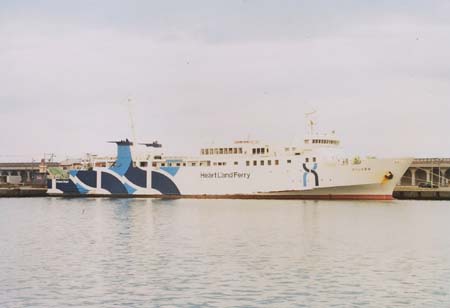
"Prince Soya" of Heart Land Ferry, Wakkanai Oct.2008 (Heiko Mueller)
|
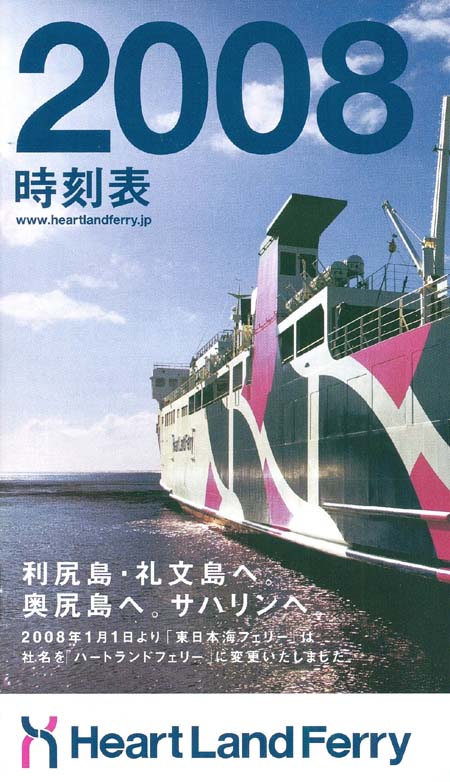
Heart Land Ferry advertisement
|
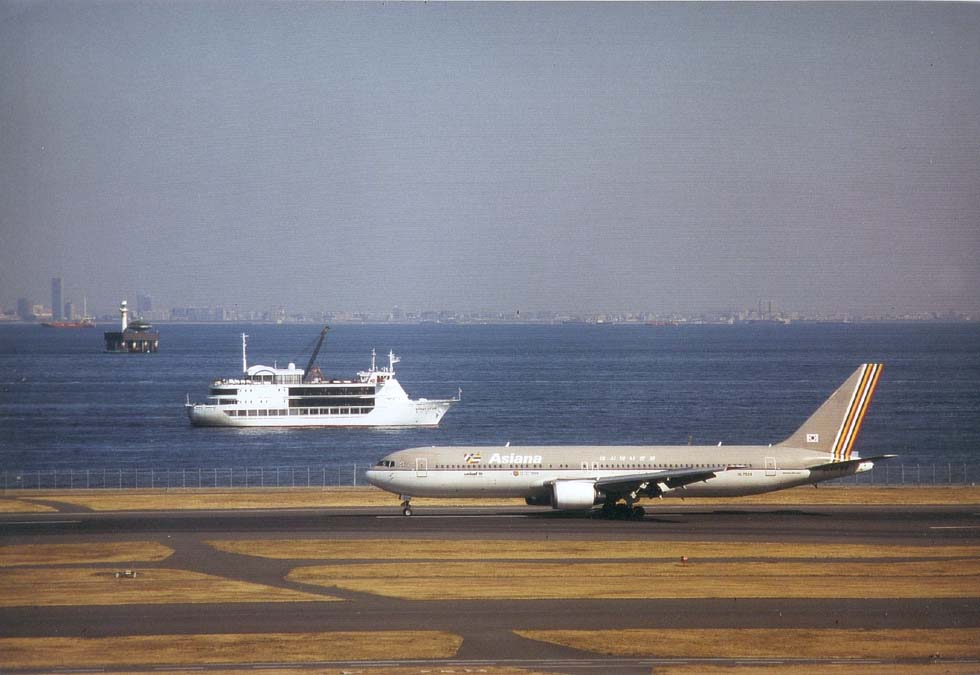
The Tokyo Bay, seen from Haneda airport, 2005 (WS)
For the railway-owned ferries of Japan in the past see also Tatsuo Furukawa: Nihon no Tedsudo Renraku Fune, or contact the Japan Domestic Ship Society. In English, William Pearce had established an excellent survey, published by the Japanese Railway Society, contact: www.japaneserailwaysociety.com.
For the connecting trains in Japan, Korea and Siberia see www.trains-worldexpresses.com.
|